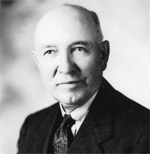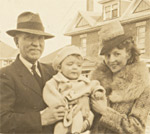
C. A. MELANSON: Célime Antoine Melanson (1885-1957) was the second president of the New Brunswick Federation of Labour, 1919-1921.
The Federation's second president was a railway machinist from Moncton who was one of the first Acadians to rise to prominence in the New Brunswick labour movement. When they chose Célime A. Melanson as president, the delegates were acknowledging the importance of Moncton and its railway workers within the labour movement. Although there were still few French-speaking delegates in attendance, they were also showing that they could welcome an Acadian as leader of the provincial labour organization. Moreover, in electing Melanson, they were choosing a hardworking skilled worker who had already served several terms as an executive officer of the Federation.
Joseph-Célime Antoine Melanson was born in rural Kent County on 23 February 1885 at Ste-Marie, then known as Mont-Carmel. He was the son of Salomée Cormier and Antoine Melanson, both descendants of families who traced their roots back to the early days of Acadia in the 17th century. At the turn of the century the young Melanson was drawn to the employment opportunities in nearby Moncton. The Intercolonial Railway was the city's largest employer, with more than 2,500 workers in 1920, about 25 per cent of them Acadians. Melanson came to Moncton at 17 years of age in 1902 and started work as a labourer in the railway repair and maintenance shops, where he was soon promoted to more skilled work as a specialist and machinist. He also continued his education by taking business and correspondence courses.
The railways were a centre of union activity, and as early as 1904 there were a dozen different railway locals in Moncton. Melanson became a member of the union in his trade, Lodge 594, International Association of Machinists. In 1914 he was chosen one of the local's delegates to the Trades and Labour Congress of Canada when it met that year in Saint John. Melanson also became a delegate to meetings of the New Brunswick Federation of Labour. He was elected as vice-president in July 1915 and again in 1916 and 1918. After James Sugrue stepped down, Melanson was a natural choice and was elected as President in March 1919.

CÉLIME A. MELANSON, 1942: Célime A. Melanson with his grandson Guy “Spique” Cormier and his daughter Fernande, in front of 55 York Street, Moncton, in 1942.
The end of the Great War was a time of high hopes for workers across the country, and New Brunswick was no exception. At the 1919 convention delegates adopted a Reconstruction Programme that called for a better future for New Brunswick workers: “The world war has forced all people to a fuller and deeper realization of the menace to civilization contained in autocratic control of the activities and destinies of mankind” . The programme called for many reforms to promote “democracy in industry” , of which the most important was full recognition of the right to organize unions, including for public employees; it called too for the eight hour day, equal pay for equal work for women and the prohibition of the employment of children under 16. The document ended with strong words stating the importance of the union movement to the province: “No element in this province is more vitally concerned in the future of the province than the working class” .
Melanson expected the union movement to play its part as one of the leading institutions in provincial society. When he issued the call for the 1920 convention, he and Secretary-Treasurer George R. Melvin urged all New Brunswick unions to send delegates: “we need the support of every Union in the Province – let this Convention be the greatest one in the history of the Federation” . As a result there were almost twice as many delegates that year, and the following year the 1921 convention was the most representative provincial assembly of labour to date, with 98 delegates from nine centres listed as in attendance, representing 7,000 workers. As president, Melanson urged union members to pursue their aims by engaging in political action at the municipal and provincial levels and collaborating with other groups, including farmers and teachers, in pursuing social reforms. He helped extend labour's influence himself, when he was elected to city council in Moncton in 1919, one of several labour aldermen elected to council and the first Acadian to occupy the position of alderman-at-large; he was re-elected again in 1920 and 1921.
At the end of the convention in Saint John in 1921, Melanson retired as President. He was paid tribute and presented with a gift at a banquet in the – unionized -- Prince William Hotel. Later that year Melanson became an assistant city clerk at Moncton City Hall, where he later rose to the position of receiver of taxes, a position he occupied until his retirement in 1952. As the newspaper L'Évangéline noted in 1921, Melanson's appointment as a municipal official was a major success for Acadians in Moncton: “He is the first French person to secure a postion of this kind and that says much about the skill and tact of our fellow citizen” . In due course Melanson emerged as one of Moncton's leading citizens; among many activities, he was a founder of the Cercle Catholique de la Jeunesse acadienne and served as a director of L'Évangéline for more than 25 years.
A journalist once described Melanson as “one of those good hard workers who do not receive enough recognition” . When Melanson died on 20 May 1957, he was so prominent that few people remembered that his path to prominence had started in the railway shops and the labour movement. Nonetheless he remained involved in labour matters to the end. In January 1940 he attended the Federation of Labour convention as a delegate of Moncton's Civic Employees Federal Union No. 51, the forerunner of Local 51, Canadian Union of Public Employees. Then in 1944 he was appointed to the Civil Service Commission, the body responsible for the employment of provincial public employees, and he was still serving in that capacity in his last years. Less than a year before his death, Melanson also attended the 44th annual convention of the New Brunswick Federation of Labour in August 1956, where he received an enthusiastic welcome as the only living Past President of the organization. At this time, when the Federation of Labour was about to merge with the New Brunswick Council of Labour to become a more inclusive body, Melanson represented an important link with the early days of the organization.